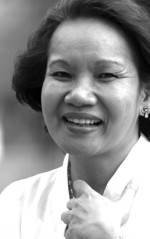
LOGARTA
She took the opportunity of the presence of the leader, so she bravely asked for a stop in quarrying. He suspected that she had been manipulated. Now she is in hiding because she heard of people searching for her. That horrified and saddened me. What is happening to us?
My students have always been encouraged to participate in class discussions. They are positively reinforced for such involvement. I often tell the class: if you do not take part in our exchange of ideas, how can I depend on your active involvement in your communities. So these students who had been active participants in class conversations are in our memory. In my first year of teaching in St. Theresa’s College during accreditation observation, Rosanne Nadela asked in a discussion on adaptation: Why do the Eskimos in freezing Alaska live in ice houses?
In UP, Jose Raymond Canoy shared ideas as well as questions, revealing a well-read young person. He has written a book and now he is a professor in Germany. Jemar Carcellar was another very active mind in the class. Jerome Garcia Neri could always be depended on to respond to thought questions on social issues. Philip Lapinid became an active participant when we discussed wars in Afghanistan. But female students like Leah Joy Dormitorio, Ria Lydia Espina, Glenda Bathan, Barbette Barbon, and Melina Almase were also into class discussions. Most of them have become lawyers. More than the answers the questions excited me, like Rene Catan (now provincial health officer) asking, what disrupted nature’s capacity to keep the balance?
In Our Lady of Joy Learning Center most moving was Rea’s comment: Ms. I do not get it at all. That was very helpful for all of us — for her classmates but especially for me. I had been given a chance to clarify the points regarding the law of supply and demand. I did not have to wait for the quiz. More effort was demanded of me, before I could see the look of understanding on their faces.
When I encourage students to be with us in the discussion it is really a struggle. There may be remains of a culture wherein children are supposed to be seen not heard. During the Spanish Colonial Period participation of women was out of the question. They were not even allowed to display themselves. They had no voice in public life because they had been limited to giving birth and raising children. With the American Colonial Period, American women did not have the right to vote, they had no voice in their political life. I teasingly asked Cesar Nemur: Why do Filipinas dance so well? (I told him this was a gender question). The answer to the question: Because they have not been allowed to speak, they communicate with their bodies!
Yet nowadays when men are asked why they maltreat their wives, some say: “She is too noisy!”
Could there be something more dramatic than the martial law shutting off of the radio stations and closing of the newspapers? — Inday Nita’s arrest in the radio station?
In many cultures, women are actually either silenced or not heard at all. I loved how Jesus came to the defense of the woman caught in adultery. He responded to their condemnatory voices in silence. It was truly revolutionary of Jesus to have a conversation with the Samaritan woman; He was even open to her discipleship.
Let us pray for patience, openness, and empathy in our hearts for all the different voices. Without the spirit of tolerance, how can we sustain a continuing improvement and development in our communities?
Disclaimer: The comments uploaded on this site do not necessarily represent or reflect the views of management and owner of Cebudailynews. We reserve the right to exclude comments that we deem to be inconsistent with our editorial standards.
